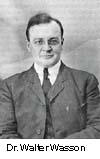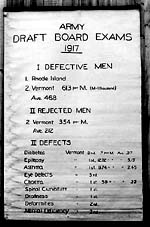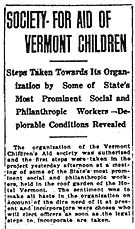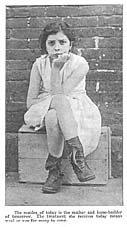

 In the late nineteenth century, Vermont leaders became increasingly self-conscious
of the effects of rural depopulation on the state's economy, its culture
and traditions, and its reputation as seed-bed of American excellence. In
the 1890s, Vermont celebrated its centennial and renewed its identity as
"the small state with the big history," through literature commemorating
the Green Mountain Boys, Vermonters' heroic efforts to abolish slavery, and
the distinguished record of leadership and public service of its native sons
and daughters who had helped create the institutions of American democracy.
Reverence for Vermont's pastoral landscape and natural beauty, carved from
the "wilderness" by the more rugged and self-reliant "old colonial stocks"
became a predominant theme in New England tourist literature, in "old home
weeks," community pageants, and local histories. Absent from the traditional
narratives on Vermont were the Western Abenaki, whose enduring presence in
their ancestral homeland and whose contributions to Vermont's culture, economy,
and celebrated identity was silenced beneath the "wilderness" myth, except
for occasional appearances of Indians in the writings of such Vermont authors
as Dorothy Canfield Fisher and Rowland E. Robinson.
In the late nineteenth century, Vermont leaders became increasingly self-conscious
of the effects of rural depopulation on the state's economy, its culture
and traditions, and its reputation as seed-bed of American excellence. In
the 1890s, Vermont celebrated its centennial and renewed its identity as
"the small state with the big history," through literature commemorating
the Green Mountain Boys, Vermonters' heroic efforts to abolish slavery, and
the distinguished record of leadership and public service of its native sons
and daughters who had helped create the institutions of American democracy.
Reverence for Vermont's pastoral landscape and natural beauty, carved from
the "wilderness" by the more rugged and self-reliant "old colonial stocks"
became a predominant theme in New England tourist literature, in "old home
weeks," community pageants, and local histories. Absent from the traditional
narratives on Vermont were the Western Abenaki, whose enduring presence in
their ancestral homeland and whose contributions to Vermont's culture, economy,
and celebrated identity was silenced beneath the "wilderness" myth, except
for occasional appearances of Indians in the writings of such Vermont authors
as Dorothy Canfield Fisher and Rowland E. Robinson.
Amid the outpouring of patriotism lurked a worry that the rural exodus had "skimmed the cream" from country farms and villages, while those who remained lacked the intelligence and resourcefulness of either the emigrants or their celebrated ancestors. The gradual replacement of Yankee farmers with immigrants, mostly French-Canadian, but also Irish, Italian, southern European, and Scandinavian, posed demographic and cultural challenges to the future dominance of Vermont's "old colonial stocks." Would the changing "racial" composition, largely French-speaking and Roman Catholic, undermine the community traditions and institutions --- the public schools, churches, and local town government --- that many state leaders proclaimed to be the embodiment and expression of Yankee Protestant ideals? This mixture of local pride and prejudice provided the cultural, political, and social landscape in which the language and ideas of the American eugenics movement took root.
 After 1900, Vermont ministers, intellectuals, and civic leaders embraced
the findings of studies and surveys as the "scientific" means to discover
the causes and extent of Vermont's social problems. References to rural degeneration,
race suicide, and inbred "pockets of degeneracy" surfaced in Vermont's own
surveys of poor relief, public education, and child welfare problems, reinforcing
popular perceptions of rural Vermonters as backward or "peculiar." Findings
of such studies, presented at conferences on college campuses and professional
meetings amplified anxieties over the decline in the quality of life in Vermont's
hamlets and villages. A reinvigoration of country schools, churches, libraries,
and recreational programs, progressive reformers argued, would reverse these
troublesome trends. State initiatives to attact tourists and turn rural districts
into summer home retreats for affluent "outlanders" complemented efforts to
improve the quality of country life by improving the quality of the people
living there.
After 1900, Vermont ministers, intellectuals, and civic leaders embraced
the findings of studies and surveys as the "scientific" means to discover
the causes and extent of Vermont's social problems. References to rural degeneration,
race suicide, and inbred "pockets of degeneracy" surfaced in Vermont's own
surveys of poor relief, public education, and child welfare problems, reinforcing
popular perceptions of rural Vermonters as backward or "peculiar." Findings
of such studies, presented at conferences on college campuses and professional
meetings amplified anxieties over the decline in the quality of life in Vermont's
hamlets and villages. A reinvigoration of country schools, churches, libraries,
and recreational programs, progressive reformers argued, would reverse these
troublesome trends. State initiatives to attact tourists and turn rural districts
into summer home retreats for affluent "outlanders" complemented efforts to
improve the quality of country life by improving the quality of the people
living there.
After 1910, human heredity and eugenics assumed a larger role in discussions
of rural decline in Vermont and its implications for the future of the state.
The emerging science of Mendelian genetics provided a scientific framework
to explain social traits -- chronic poverty, crime, and immoral conduct--
in terms of hypothetical genes for feeblemindedness, insanity, alcoholism,
and criminal tendencies. Prominent Vermont physicians attributed health problems
encountered in clinical practice to "bad heredity" and advocated segregation
or sterilization of the genetically "unfit," as evidenced by their commentaries
at professional meetings and in medical journals. At the urging of Governor
John A. Mead, a physician, the  Vermont legislature passed a sterilization law in 1912, which was vetoed
by his successor, Governor Allen Fletcher on the advice of the attorney general.
Vermont legislature passed a sterilization law in 1912, which was vetoed
by his successor, Governor Allen Fletcher on the advice of the attorney general.
Beginning in 1912, the Vermont legislature passed a succession of new laws to assist and relieve towns of their poor, their disabled, and their orphaned, neglected, or indigent children. At the urging of progressive reformers, the state constructed a State School for the Feebleminded at Brandon, which opened in 1915. The same year, the Child Welfare Law legally defined "dependent, neglected, and delinquent" children and authorized any "reputable citizen" to report suspected cases and enabled the courts, with the help of private and public charities, to investigate complaints and take custody of such children and place them in foster care or state institutions.
In 1916, Vermont progressive reformers organized the Vermont Conference of Charities and Correction for the purpose of "agitation and discussion" of child health and family welfare problems in Vermont and to recommend social legislation based on studies of Vermont's needs. Their crusade to modernize and centralize authority over public health, education and welfare programs challenged Vermont's long-standing tradition of local, town-based control.
In 1917, at the urging of VCCC leaders, the Vermont legislature approved Mother's Aid allowances to supplement town poor relief and established the State Board of Charities and Probation to locate and register all neglected, dependent, or delinquent children and to oversee town enforcement of the child welfare laws. In response to Norwich Professor K. R. B. Flint's 1916 survey, Poor Relief in Vermont, the state legislature prohibited the placement of children in poorhouses and on poor farms, making the Brandon State School for the Feebleminded and the Vermont Industrial School for juvenile delinquents attractive options for town officials who could not arrange for foster care of "neglected and dependent" children. Within three years the Brandon School for the Feebleminded was filled to capacity, and the "waiting list" was growing.
 The effects of war and disease strengthened the resolve of progressive reformers
to convince the state to become "the child's first guardian" through enactment
of social programs for early detection and prevention of health and developmental
"defects." Vermont's national ranking in the Army Draft Board examinations
alerted state leaders to the need for reform. Vermont had produced some
of the highest rates of draft rejections for various physical and mental
defects. Most of these, Public Health Secretary Dr. Charles Dalton argued,
could have been prevented if they had been discovered and treated in early
childhood. Others wondered if "poor inheritance" had contributed to the apparent
"ineffciency" of Vermont's draftees.
The effects of war and disease strengthened the resolve of progressive reformers
to convince the state to become "the child's first guardian" through enactment
of social programs for early detection and prevention of health and developmental
"defects." Vermont's national ranking in the Army Draft Board examinations
alerted state leaders to the need for reform. Vermont had produced some
of the highest rates of draft rejections for various physical and mental
defects. Most of these, Public Health Secretary Dr. Charles Dalton argued,
could have been prevented if they had been discovered and treated in early
childhood. Others wondered if "poor inheritance" had contributed to the apparent
"ineffciency" of Vermont's draftees.
The Spanish flu epidemic of 1918, however, prompted more direct action.
Mortality was high among the young adult population and among those caring
for the sick. Dr. Caverly, Secretary of the State Board of Health, and Dr.
Walter Wasson, Superintendent of Waterbury State Hospital, both perished
in the epidemic. Some communities were hit especially hard, leaving many
families desperate. The Vermont Conference of Social Work launched a state-wide
survey in 1919 to assess the needs of children orphaned in the crisis. The survey's findings mobilized support for the founding of the Vermont
Children's Aid Society, whose mission was to "engage in child welfare work
and in social service designed to maintain the integrity of wholesome family
groups... and the carrying on of such work of prevention, relief, and remedy
as will safeguard the welfare of minors and of the home."
The survey's findings mobilized support for the founding of the Vermont
Children's Aid Society, whose mission was to "engage in child welfare work
and in social service designed to maintain the integrity of wholesome family
groups... and the carrying on of such work of prevention, relief, and remedy
as will safeguard the welfare of minors and of the home."
 Over the next five years, Children's Aid Society case workers L. Josephine
Webster and Harriett E. Abbott collaborated with the State Board of Charities
and Probation, the newly formed Department of Public Welfare, the courts,
and town officials to implement child welfare laws, to rescue children from
"unsuitable homes," and to accumulate evidence for legislative reforms in
the interest of preserving wholesome family groups. In the early 1920s, the
themes of motherhood, child health and education, and disease prevention
provided the cornerstones for co-operative ventures between state and private
agencies to nurture and protect "Vermont's greatest asset - her children."
Over the next five years, Children's Aid Society case workers L. Josephine
Webster and Harriett E. Abbott collaborated with the State Board of Charities
and Probation, the newly formed Department of Public Welfare, the courts,
and town officials to implement child welfare laws, to rescue children from
"unsuitable homes," and to accumulate evidence for legislative reforms in
the interest of preserving wholesome family groups. In the early 1920s, the
themes of motherhood, child health and education, and disease prevention
provided the cornerstones for co-operative ventures between state and private
agencies to nurture and protect "Vermont's greatest asset - her children."
The voices of Vermont progressives in the 1910s and 1920s reveal the receptive audience zoology professor Henry F. Perkins found for his "Good Eugenics Program for Vermont." In 1925, he proposed his idea of a Eugenics Survey of Vermont to this coalition of social reformers, his first and most important constituency.